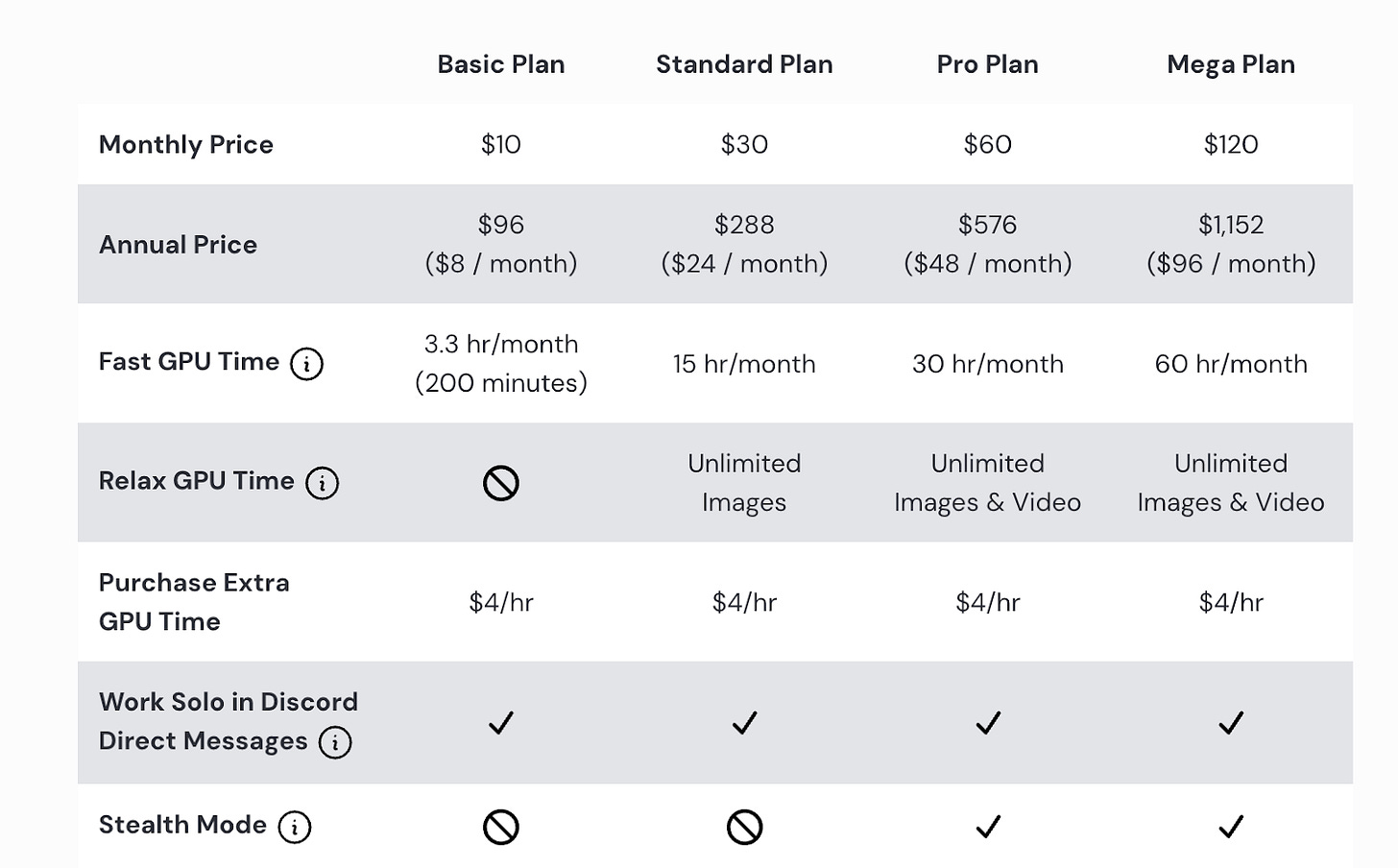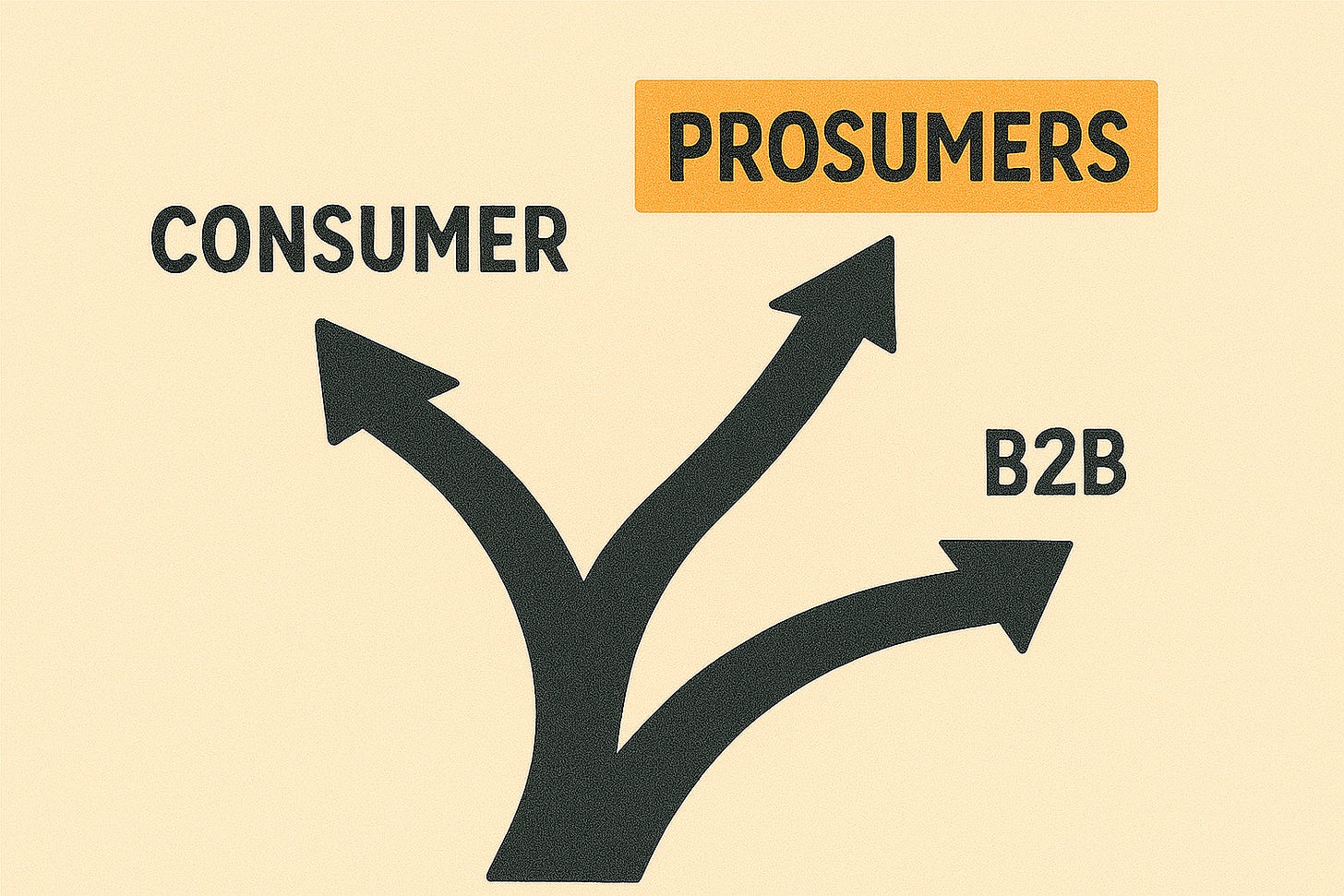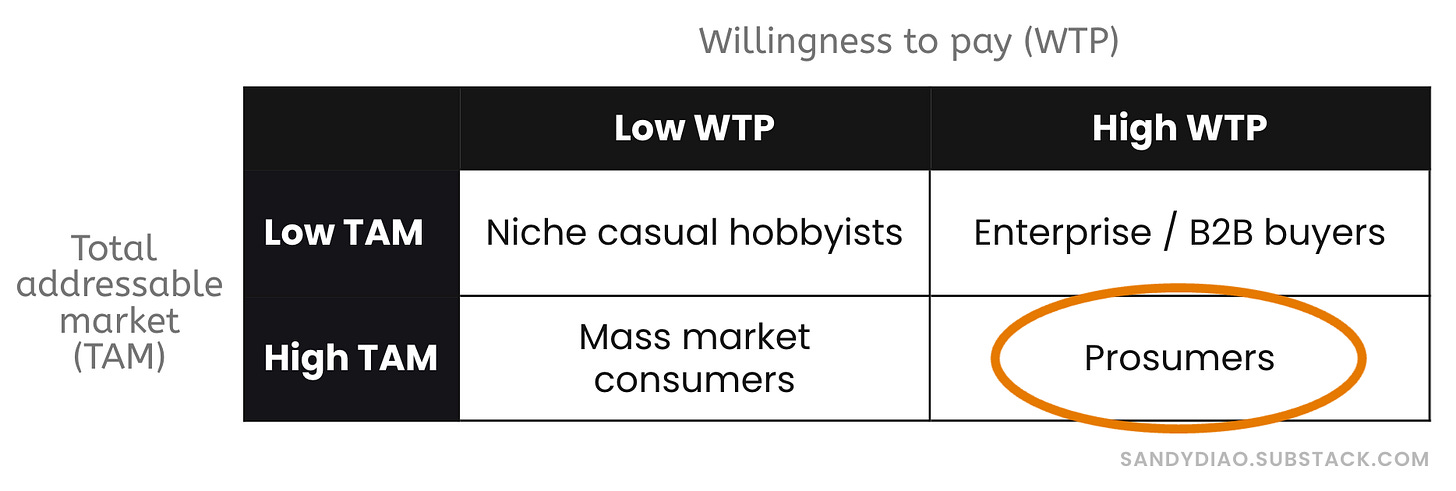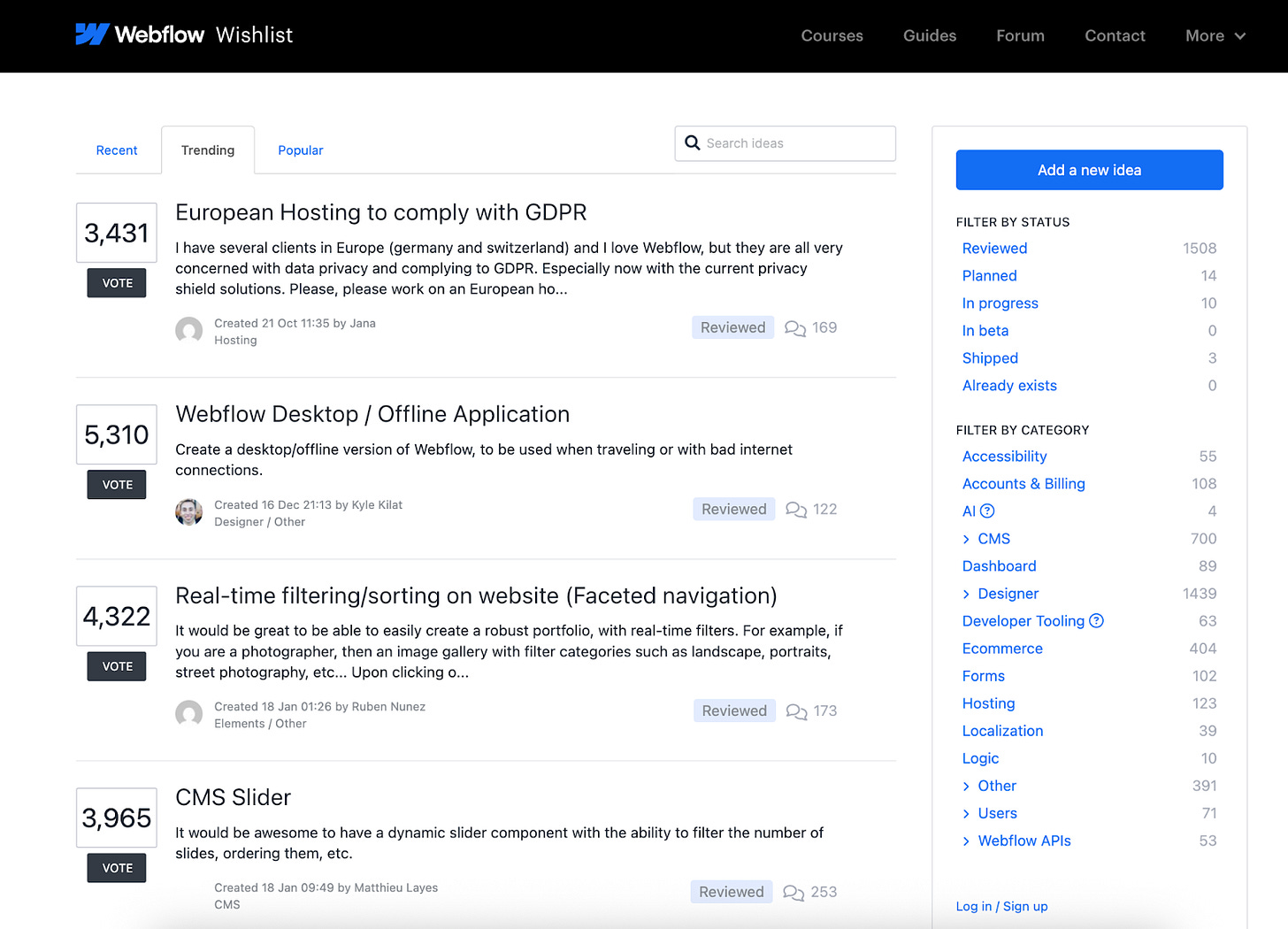Why prosumers are the most overlooked GTM wedge in tech
Forget B2B vs B2C: a prosumer-first strategy allows scale without sacrificing monetization. Here’s why prosumers are the most overlooked growth segment, and how to build a strategy around them.
“Should I launch this as a consumer or a B2B product?”
Founders often ask me this when working on their go-to-market strategy.
It’s an understandable question, especially because of the tradeoffs it imposes. Consumer GTM promises a massive TAM (total addressable market), but those users have a lower willingness to pay. B2B means larger ACVs (annual contract value), but it comes with longer sales cycles and a buyer pool you could probably list on a spreadsheet.
Most founders assume it’s a binary choice. Or you pick one and go with the other later.
But for SaaS products that can serve both individuals and businesses, there’s a third path, a go-to-market segment that almost nobody names aloud. One that gives you the best of both worlds: targeting prosumers.
These users are the most overlooked GTM wedge in technology.
Betting on prosumers first has been the secret to some of the fastest-growing companies of the last decade - a list that includes companies like Notion, Arc, Loom, Webflow, Framer, Canva, Descript, Runway, or Gamma - and this barely scratches the surface.
They all started with prosumers because this segment gives you something rare in software: scale without sacrificing monetization. They sit in the sweet spot between massive consumer reach and enterprise-level willingness to pay.
What is a prosumer?
Looking at the etymology of “prosumer” helps us understand the concept: the term is a combination of the words “producer” and “consumer”.
It refers to someone who discovers and shops software like a consumer, namely through self-service sign-ups, reviews, and word of mouth, but uses it for productivity or business purposes.
A few examples of prosumers:
A solo creator paying for Descript or Kapwing to edit videos
An indie developer building an app on Framer or Supabase
A designer running a side hustle with Canva or Webflow
A power user at a company paying for Gamma or Cursor out of pocket
The main difference between a prosumer and a consumer in B2C is that the former is professionally motivated, value-driven, and often influential in their circles.
They act as early adopters and are great engines for word of mouth and referrals. They share tools with peers, teach others how to use them, and in many cases, bring those tools into the companies where they work.
Why prosumers are the best first segment to target
If you’re launching a new product, here are a few reasons to consider targeting prosumers as your first segment:
1. They’re targetable via intent
Prosumers always have a clear use case. They have a problem to solve and are actively looking for solutions across search, YouTube, research tools like Perplexity, or forums like Reddit.
These are all places you can reach, meeting your prospects exactly where they are. Unlike broad consumer audiences, you don’t need to manufacture demand. It’s already there.
Descript, for instance, captures searches like “free transcription tool” and “filler word removal” to reach high-intent prosumers who are actively looking for tools to use in their audio or video workflows.
2. They’re self-serve friendly
Prosumers prefer to try out products without talking to sales.
They want to start using it right away, get value immediately and pay with a credit card. Fast.
This is great news for you: no need to build out sales or customer success teams in the early days. The product onboarding does the work, and you just need to ensure the product flows are set up in the best possible way.
Think of Notion: they reached their first million users without a heavy sales team, just pure PLG, powered by community.
3. They pay early and often
I often see founders trading off traction for monetization. This is especially true in B2C, where startups prefer to get users in the door first, and address revenue later, given their low willingness to pay.
But prosumers are not your typical consumer. They are willing to pay from day one for outcomes, whether that’s removing background noise from a podcast, generating a landing page, or shipping an app faster. What matters to them is the result.
They’ll swipe a credit card for value, and they’re comfortable with pricing tied to usage or output. This means you can start monetizing early without killing adoption.

4. They have expansion potential
Prosumers help you expand in two ways.
First, when usage grows, so does their desire to use higher-priced tiers. As long as the higher plan solves a problem through a clear output, prosumers are willing to upgrade.
Second, they tend to work in close-knit communities, like creator groups, or in teams at companies, and are a fantastic word of mouth engine. Creators share tools on YouTube, developers tweet about their stack, and employees bring personal tools into work and convert teams into paying accounts.
That’s expansion without cold outreach, paving the way for a product-led sales motion.
5. They give you fast, high-quality feedback
Prosumers use your product at a highly regular cadence, and more usage means more data to iterate on. They’re also very vocal about what works in the product and what doesn’t.
Look at Webflow: its forum became a roadmap engine early on, with small brand owners pushing for CRM features, integrations, and advanced design options. That feedback loop accelerated product-market fit in ways enterprise-only roadmaps rarely can.
How to build a prosumer GTM motion
Most companies fail at prosumer GTM because they adopt the wrong playbook. It’s neither B2C nor enterprise. It’s a category of its own, and it comes with its own rules.
1. Positioning: sell outcomes, not features
A comprehensive set of features? Leave that for B2B clients.
Aspirational messages? Better suited for B2C.
With prosumers, what works is talking about outcomes. They want to get something done faster, easier or cheaper.
Take Lovable’s example: they are a scalable modular CMS infrastructure, but that’s not how they position themselves. Instead, their tagline is “Build apps and websites by chatting with AI”.
2. Pricing: accessible, with a growth path
Keep pricing accessible, offering at least two plan types with a clear growth path from one to the other. The first one should be free or low-cost, leading to an upgrade as usage grows. The key is tying pricing to outcomes or usage, as this makes value transparent and sets the stage for expansion without friction. Think of Runway or Midjourney: clear tiers, clear upgrade paths.

3. Distribution: best of both B2C & B2B playbooks
Prosumers behave like consumers in where they discover tools, but like B2B buyers in how they evaluate them. That means your distribution strategy should combine elements of both motions:
SEO/GEO for intent capture: Target queries that indicate high-intent, like “AI video editor” or “best podcast tool.” Descript grew through aspiring podcasters searching for transcription keywords.
Creator partnerships and affiliate programs for trust: Webflow’s affiliate program turned creators into advocates, building a highly engaged audience.
Product entry points such as templates, libraries, and galleries: Canva uses templates to remove friction from onboarding and accelerate time-to-value.
Community-driven distribution: Engage on platforms where prosumers exchange ideas and recommendations, like X, Discord, and Reddit. Replit leveraged these communities to build awareness and create advocates.

4. Retention: build habits with product cues
Your onboarding should enable self-serve value, monetization awareness, and habit formation. This means focusing on using the product to drive as much of the setup, value discovery, and pricing plan discovery as possible. Then reinforce usage with lifecycle nudges like notifications, emails, and in-product messaging, instead of trying to use customer success to guide towards more usage and engagement.
Canva does a great job with this: they guide users through setup with low-effort templates, and then clearly signal which features are gated behind the Pro plan using intuitive icons. When you interact, Canva reminds you to upgrade with the features, but also continues to recommend related templates to you based on what you’re making to deepen your usage.

5. Expansion and viral growth: build share loops
One of the most effective ways to grow a prosumer product is to make sharing a natural part of product usage. When users create something valuable, like a design or document, they’re often compelled to show it off. This behavior can become a powerful growth engine.
Add user-generated content loops that encourage sharing. Include watermarks, shareable links, and embedded outputs, as these are all powerful elements of a distribution engine.
For example, Notion has a robust share loop through their document and template-sharing features. Many prosumers, especially creators, publish Notion templates for use cases in productivity, planning, resume building, and more, allowing the viewers of those pages to duplicate the templates for themselves. These shared pages not only deliver value, but also drive more signups and fast activation.
Why this matters now
The rise of AI workflows has created a perfect storm for prosumer-first companies.
Knowledge workers and creators are experimenting with new tools every day, often outside the constraints of corporate software budgets. At the same time, SaaS procurement is tightening, and enterprise contracts are the first to be cut, while individually purchased tools often stick.
That’s why the next decade’s breakout products won’t start at the top of the organization chart. They’ll start in the hands of prosumers, those who move fast, pay for value, and bring the tools they love into their teams.
“Should I launch my product to consumers or businesses?” The answer to our initial question might be “neither”. Instead, the third path could be your smartest bet. If you want to discuss how to make prosumers your first GTM engine, reach out, I’d love to help.





